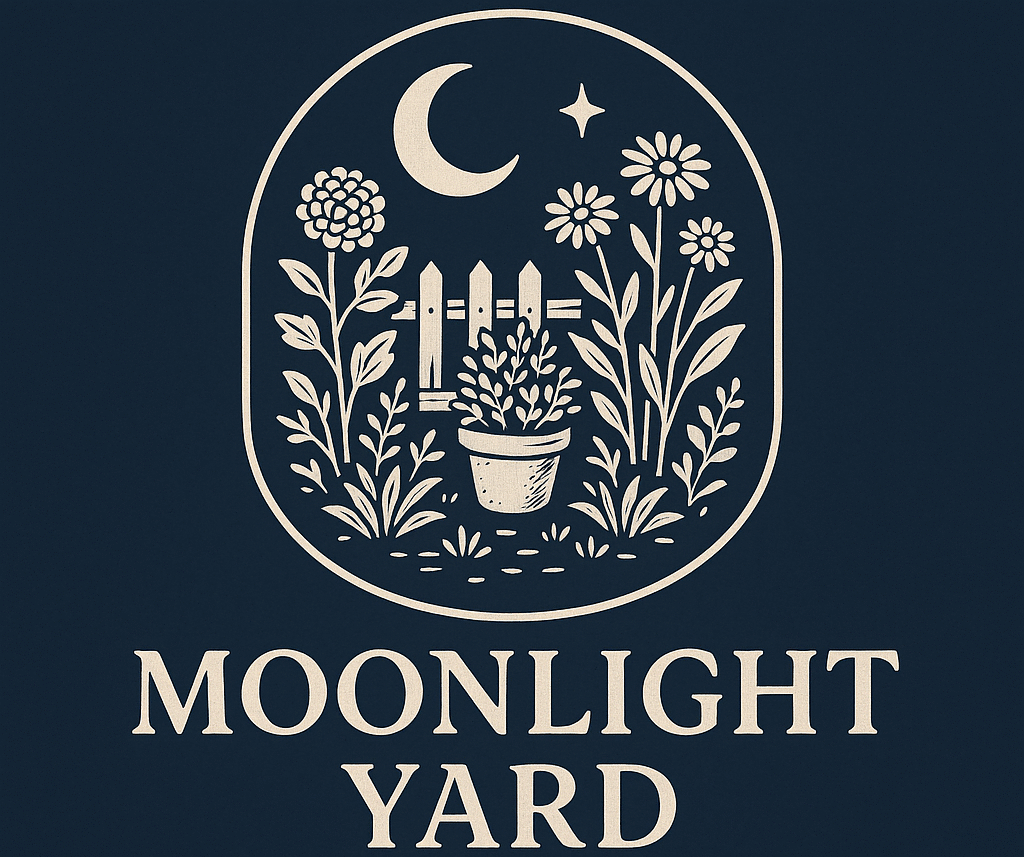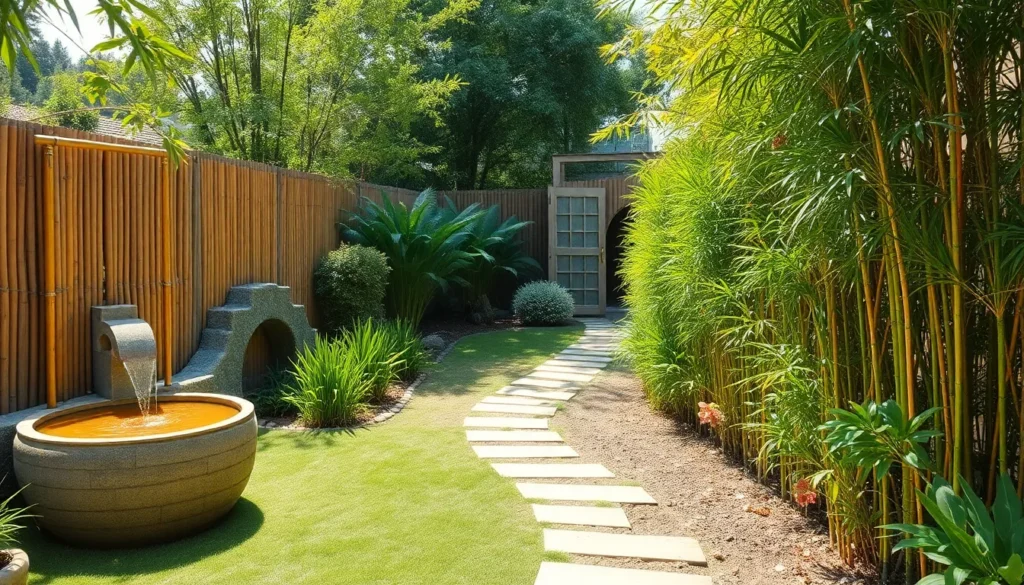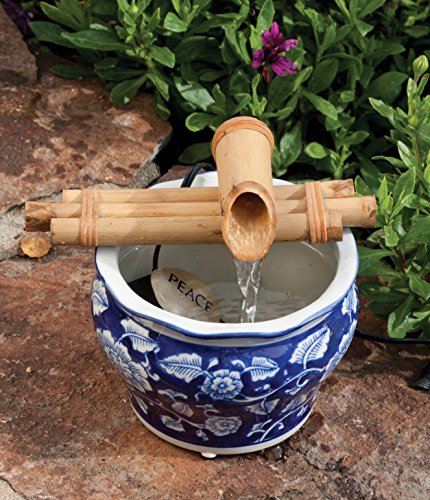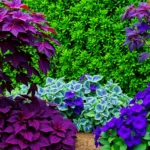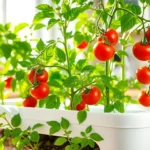We’ve all dreamed of transforming our outdoor spaces into stunning retreats that blend natural beauty with practical functionality. Bamboo offers the perfect solution for creating these garden sanctuaries while maintaining an eco-friendly approach to landscaping.
This versatile plant isn’t just about creating privacy screens anymore. We’re seeing innovative gardeners use bamboo for everything from decorative water features and sculptural elements to functional pathways and sustainable planters. The best part? Bamboo grows quickly and requires minimal maintenance once established.
Whether you’re working with a compact urban balcony or sprawling backyard we’ll explore creative bamboo applications that’ll elevate your garden’s aesthetic appeal. From modern minimalist designs to tropical paradise themes these ideas will help you harness bamboo’s natural elegance while solving common landscaping challenges.
Create Natural Privacy Screens With Bamboo Hedging
Moving beyond decorative applications, bamboo hedging offers one of the most effective and sustainable ways to establish privacy in our outdoor spaces. We can transform exposed areas into secluded retreats while maintaining the natural beauty that makes bamboo such an appealing garden choice.
Choose Clumping Varieties for Controlled Growth
Selecting clumping bamboo varieties ensures our privacy screens stay exactly where we want them without becoming invasive garden nightmares. These species form tight clusters that expand slowly outward rather than sending runners throughout our entire industry.
Fargesia robusta grows 10-13 feet tall and thrives in both sun and partial shade, making it perfect for most property line applications. This variety withstands temperatures down to -10°F and requires minimal maintenance once established.
Bambusa multiplex reaches 8-25 feet depending on the cultivar and creates dense screens that block both sight and sound effectively. We particularly recommend the ‘Alphonse Karr’ cultivar for its striking yellow canes with green stripes.
Fargesia nitida stays compact at 8-12 feet while producing incredibly dense foliage from ground level to canopy. This species handles windy conditions better than most bamboo varieties, making it ideal for exposed locations.
Install Along Property Lines for Maximum Coverage
Installing bamboo hedging strategically along our property boundaries creates the most comprehensive privacy coverage while maximizing our garden’s usable space. We should position plants 18-24 inches from actual property lines to allow for mature growth without encroaching on neighbors’ spaces.
Corner plantings deserve special attention since these areas typically receive the most visual exposure from multiple angles. Placing our tallest bamboo specimens at corners creates natural anchor points that frame our entire privacy screen.
Gate areas benefit from slightly wider spacing to accommodate foot traffic while maintaining visual continuity. We can install bamboo posts or panels between plantings to fill gaps without restricting movement.
Utility access points require careful planning to ensure our privacy screens don’t interfere with maintenance needs. Positioning clumping bamboo at least 4 feet from utility boxes or HVAC units prevents future conflicts while preserving screening effectiveness.
Maintain Proper Spacing for Healthy Development
Proper spacing between bamboo plants determines both the speed of coverage and the long term health of our privacy screens. We must balance our desire for immediate results with the need for sustainable growth patterns.
Standard spacing of 6-8 feet between centers works best for most clumping varieties and allows each plant room to reach its full potential. This distance creates solid coverage within 2-3 growing seasons while preventing overcrowding issues.
Closer spacing of 4-5 feet accelerates coverage but requires more aggressive pruning to prevent competition between plants. We use this approach when immediate privacy is essential and we’re committed to regular maintenance.
Wider spacing of 10-12 feet suits larger properties where we can afford longer establishment periods. This approach reduces initial costs and allows each plant to develop its natural shape without interference from neighbors.
| Spacing Distance | Coverage Timeline | Maintenance Level | Best For |
|---|---|---|---|
| 4-5 feet | 1-2 seasons | High | Immediate privacy needs |
| 6-8 feet | 2-3 seasons | Medium | Standard applications |
| 10-12 feet | 3-4 seasons | Low | Large properties |
Design Stunning Bamboo Garden Pathways
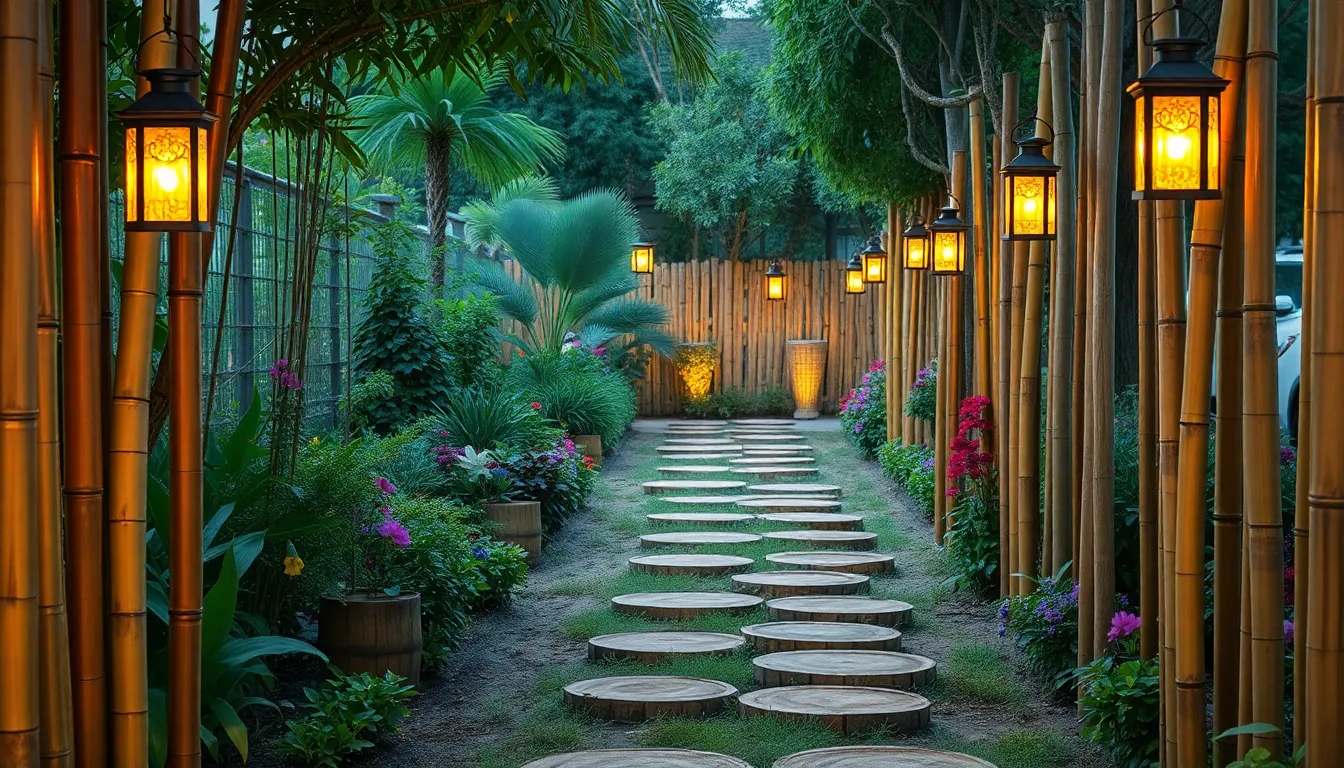
Transform your garden’s accessibility while improving its natural beauty through thoughtfully designed bamboo pathways. These sustainable walkways combine functionality with visual appeal to create inviting routes throughout your outdoor space.
Use Cut Bamboo Poles as Pathway Borders
Cut bamboo poles offer an excellent solution for defining pathway edges with natural rustic charm. Simply position these poles along both sides of your walkway to create clear visual boundaries between different garden sections. This approach provides immediate demarcation while adding organic texture that complements surrounding plantings.
Installation becomes straightforward when you hammer the poles directly into the ground at regular intervals. We recommend spacing them 3-4 feet apart for optimal visual impact while maintaining structural integrity. The natural golden hues of aged bamboo poles blend seamlessly with most garden color schemes, from vibrant flower beds to subtle green foliage areas.
Create Stepping Stone Patterns With Bamboo Rounds
Bamboo rounds deliver an eco-friendly alternative to traditional stone stepping stones while adding unique texture to your pathways. These circular cross-sections can be placed at 18-24 inch intervals to accommodate comfortable stride lengths for most adults. The natural grain patterns in each round create visual interest that draws the eye forward along the path.
Preparation involves cutting mature bamboo culms into 2-3 inch thick sections using a sharp saw to prevent splitting. We suggest treating these rounds with natural sealers to extend their lifespan in outdoor conditions. Strategic placement allows you to incorporate gentle curves that feel more organic than rigid straight lines.
Add Lighting Elements for Evening Appeal
Lighting elements transform bamboo pathways into enchanting evening destinations that extend your garden’s usability after sunset. Solar lights positioned between bamboo borders create a gentle glow that guides visitors safely while maintaining the natural aesthetic. Uplighting techniques can highlight the texture of bamboo poles while casting interesting shadows on surrounding vegetation.
Lantern-style fixtures complement the organic feel of bamboo materials better than harsh LED spotlights. We’ve found that warm white lights (2700K-3000K color temperature) enhance the golden tones of weathered bamboo without overwhelming the peaceful garden atmosphere. String lights woven through taller bamboo installations add whimsical touches perfect for evening gatherings or quiet contemplation.
Build Functional Bamboo Trellises and Support Systems
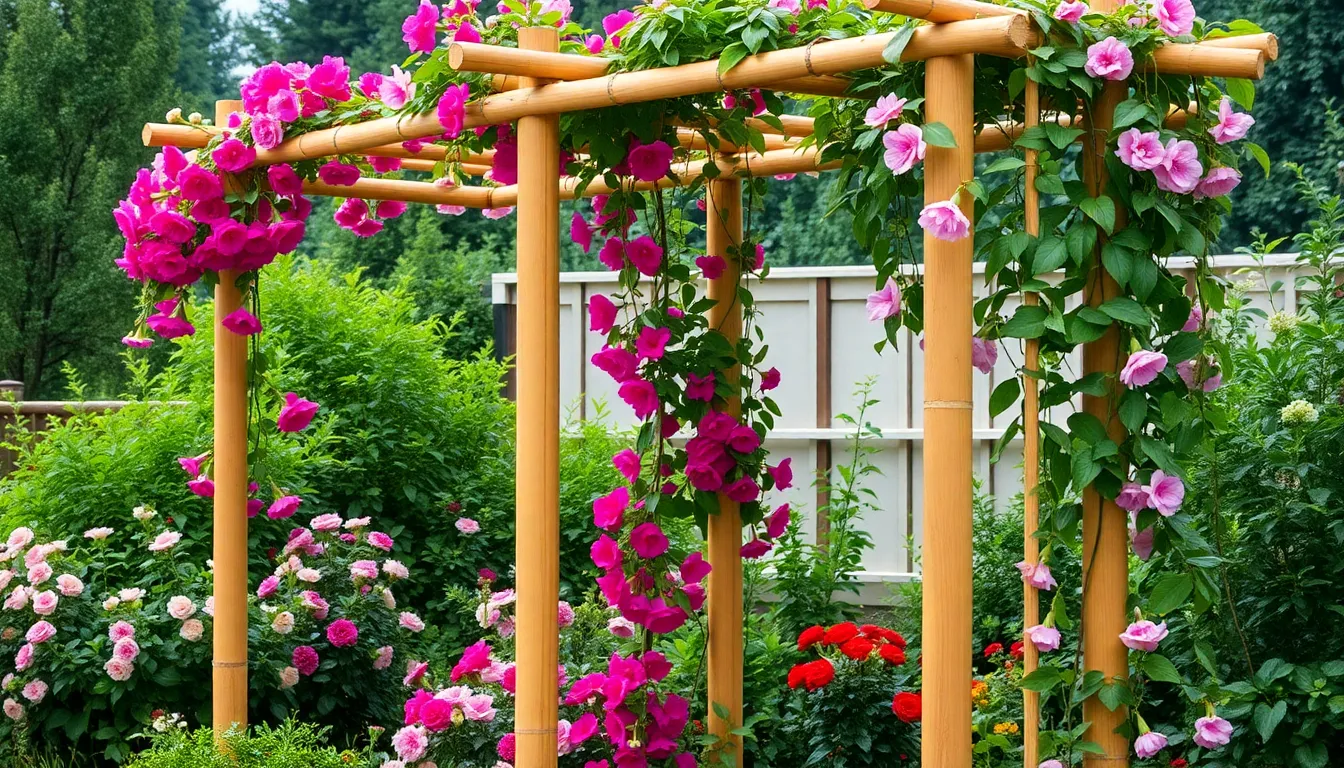
Bamboo transforms into incredibly versatile support structures that rival traditional materials in both durability and cost effectiveness. We’ll explore three distinct approaches to creating bamboo garden supports that enhance your climbing plants while adding natural beauty to your outdoor space.
Construct Climbing Plant Supports
Individual bamboo stakes provide excellent support for climbing plants like peas, beans, and roses. We recommend using stakes that are 6-8 feet tall for most climbing vegetables, ensuring they’re buried at least 18 inches deep for stability. Weaving multiple bamboo poles together creates stronger framework systems that can handle heavier climbing plants such as ivy and clematis.
Creating interconnected bamboo grids offers superior support compared to single stake methods. We space vertical bamboo poles 2-3 feet apart and connect them with horizontal crosspieces using natural twine or zip ties. This technique works exceptionally well for vigorous climbers that need multiple attachment points throughout their growing season.
Design Vertical Garden Structures
Vertical bamboo planters maximize growing space in compact garden areas while creating stunning living walls. We construct these systems by securing bamboo poles vertically against fences or standalone frames, then attaching small planters or pockets at regular intervals. This method allows us to grow herbs, strawberries, and small flowering plants in areas where ground space is limited.
Wall mounted bamboo trellises transform blank outdoor surfaces into productive growing areas. We attach bamboo frameworks directly to walls using heavy duty brackets, creating geometric patterns that support climbing plants while serving as decorative elements. These structures work particularly well for urban gardens where vertical space utilization is essential.
Create Artistic Archway Entrances
Bamboo archways serve as stunning focal points that frame garden entrances and pathways. We bend flexible bamboo poles into graceful curves and secure them with buried foundation posts, creating natural doorways that welcome visitors into different garden sections. These arches typically require 10-12 foot bamboo poles for proper proportions and structural integrity.
Decorating bamboo arches with climbing plants enhances their visual impact throughout growing seasons. We plant flowering vines like morning glories or jasmine at the base of each arch, allowing them to naturally climb and create living canopies. Adding string lights or lanterns to bamboo archways extends their beauty into evening hours, creating magical garden transitions.
Establish Bamboo Water Features for Tranquil Ambiance
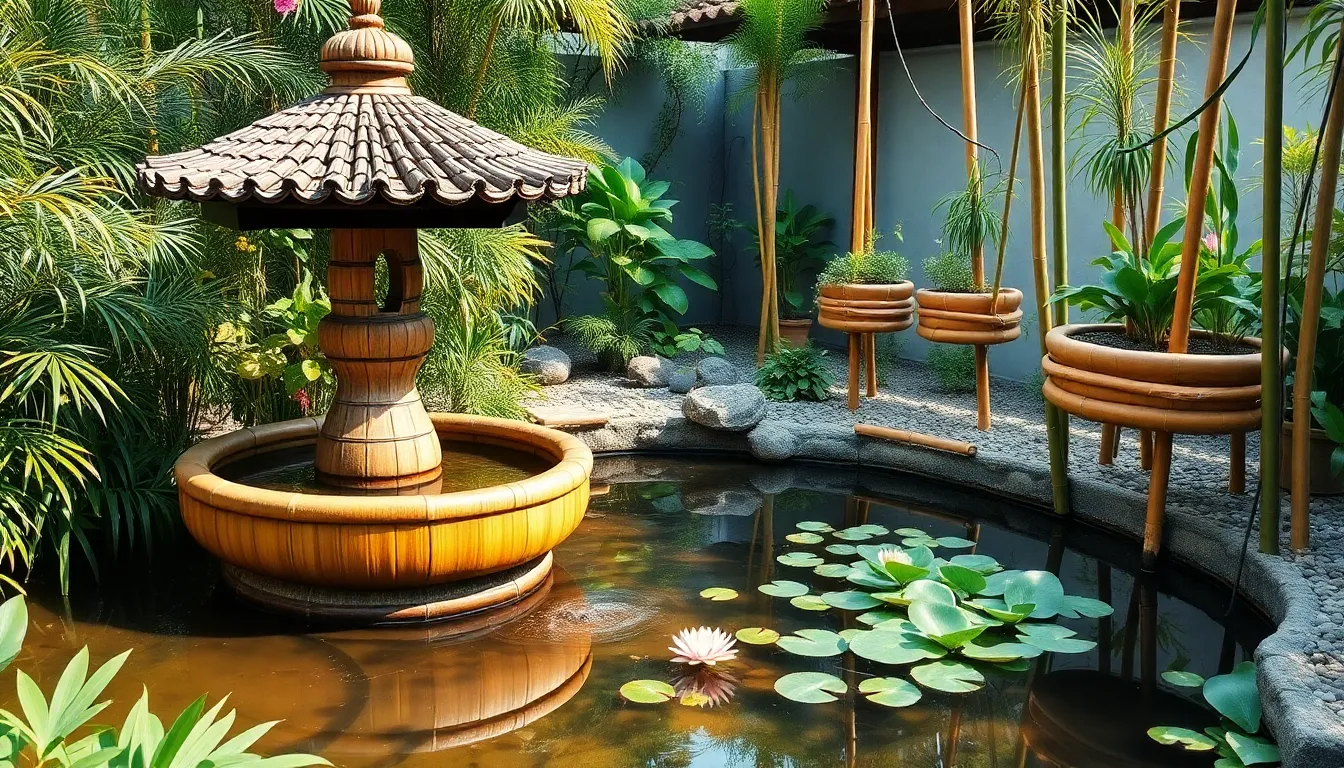
Water features transform any garden space into a peaceful retreat, and bamboo naturally complements these soothing elements with its organic textures and sounds.
Install Traditional Bamboo Fountains
Traditional bamboo fountains create mesmerizing soundscapes that mimic natural waterfalls throughout your garden space. We recommend starting with DIY bamboo fountains since they’re easy to construct using simple components like bamboo poles, water pumps, and collection basins. Customization options allow you to match any garden style, from minimalist zen designs to elaborate multi-tiered installations featuring troughs, waterwheels, and multiple bamboo spouts.
Solar-powered bamboo fountains offer an energy-efficient solution that’s perfect for patios, balconies, and smaller garden areas. These systems reduce electricity consumption while maintaining the tranquil ambiance you’re seeking. Shishi Odoshi fountains provide a unique auditory experience with their characteristic periodic clapping sounds that punctuate the gentle flow of water through bamboo channels.
Design Bamboo Channel Water Systems
Bamboo water channels create continuous flowing features that weave through your garden industry with natural elegance. We suggest designing these systems to connect different garden zones, allowing water to travel from elevated areas down through planted beds and gathering spaces. Integration with existing industry elements like rock gardens, plant borders, or small waterfalls enhances both visual appeal and sound dynamics.
Channel systems can incorporate varying bamboo diameters to create different water flow rates and sounds. Wider bamboo sections produce deeper, more resonant tones, while narrower channels create gentle trickling effects. Strategic placement of collection pools along the channel route provides opportunities for aquatic plants and creates natural gathering spots for wildlife.
Incorporate Bamboo Accents in Existing Ponds
Existing pond areas benefit tremendously from thoughtful bamboo integration that enhances their natural beauty. We recommend using bamboo as planters around pond perimeters, creating elevated growing spaces for aquatic plants like water lilies, lotus, and ornamental grasses. These bamboo planters provide habitat diversity for pond wildlife while maintaining clean sight lines to the water surface.
Bamboo decorations blend seamlessly with pond environments, offering vertical elements that contrast beautifully with horizontal water surfaces. Strategically placed bamboo poles can support climbing plants that cascade toward the water, creating natural privacy screens and wildlife corridors. Consider installing bamboo wind chimes near pond areas to add gentle musical elements that complement the water’s natural sounds.
Craft Decorative Bamboo Garden Containers and Planters
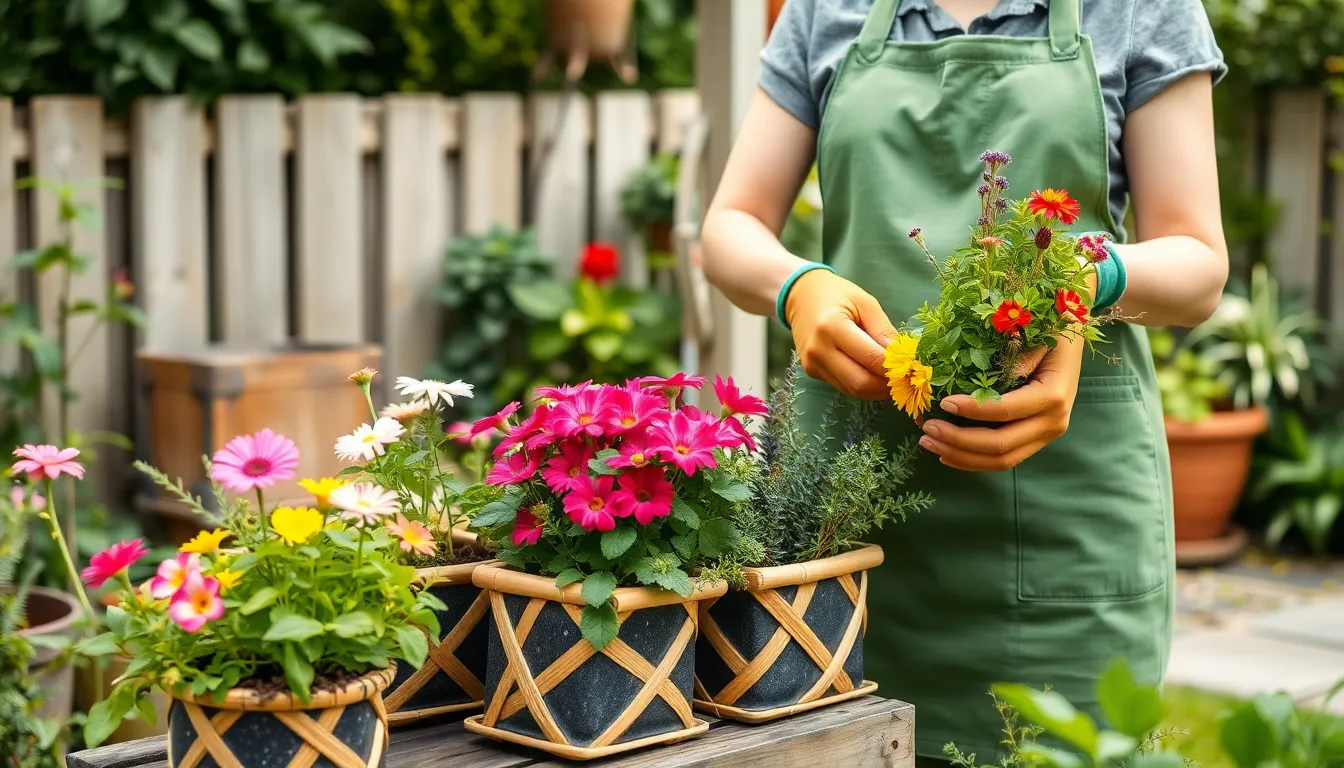
Bamboo containers offer a versatile and sustainable approach to garden design, blending functionality with natural aesthetic appeal. Creating your own bamboo planters allows us to customize container sizes while maintaining the organic texture that complements both contemporary and Zen-style garden themes.
Repurpose Large Bamboo Culms as Planters
Large bamboo culms transform into unique cylindrical planters with minimal preparation and maximum visual impact. We can cut mature bamboo sections to our desired height, typically 12-18 inches for optimal plant growth, and seal one end to create a natural drainage system. These repurposed culms work exceptionally well for herbs like basil and cilantro, small flowering plants such as marigolds and petunias, or drought-resistant succulents including jade plants and echeveria.
The organic texture of bamboo culms adds authentic character to garden spaces while effectively upcycling construction excess or garden waste materials. Each planter showcases bamboo’s natural node patterns and golden hues, creating conversation pieces that highlight sustainable gardening practices.
Create Hanging Garden Displays
Hanging bamboo containers maximize vertical space while creating layered garden effects that work perfectly for balconies, patios, and areas with limited ground space. We can suspend bamboo planter boxes from walls using sturdy brackets, hang them from pergola beams, or create ceiling displays that draw the eye upward and add depth to compact spaces.
Vertical bamboo planters use garden space efficiently by accommodating trailing plants like ivy and pothos, cascading flowers such as petunias and lobelia, or even compact vegetables including cherry tomatoes and lettuce. The lightweight nature of bamboo makes these hanging systems practical for various mounting surfaces without requiring heavy-duty hardware.
Design Tiered Planting Systems
Tiered bamboo planters create visually ever-changing displays while organizing plants at different heights for optimal growing conditions and accessibility. We can stack bamboo containers of varying sizes to form multi-level arrangements, or construct staggered bamboo shelving systems that prevent overcrowding while maximizing growing space in small gardens.
| Tier Configuration | Plant Types | Spacing Requirements |
|---|---|---|
| 3-Level System | Herbs, flowers, trailing plants | 8-12 inches between levels |
| Staggered Design | Mixed vegetables, ornamentals | 6-8 inches vertical spacing |
| Cascading Setup | Succulents, air plants | 4-6 inches between containers |
These multi-level systems work effectively in corner spaces, against walls, or as standalone features that add architectural interest to garden layouts. The strength and flexibility of bamboo allow for creative configurations that can be easily modified as plants grow or seasonal needs change.
Develop Bamboo Seating Areas and Garden Furniture
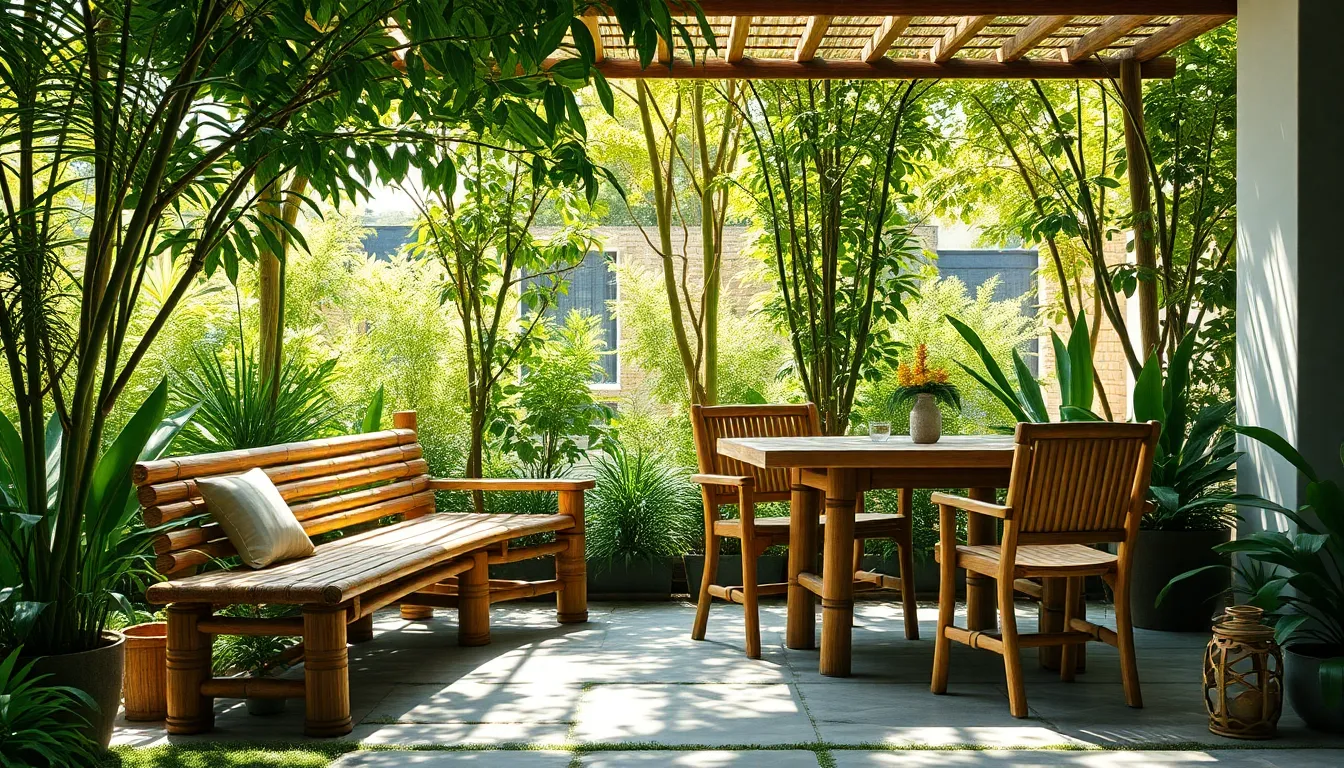
Creating comfortable seating areas with bamboo transforms our outdoor spaces into inviting gathering spots. We’ll explore practical furniture options that combine sustainability with natural beauty.
Build Simple Bamboo Benches
Simple bamboo benches offer natural seating options that enhance any garden space. We can construct these durable pieces using thick bamboo culms as the main frame, connecting them with traditional joinery techniques or modern hardware. Bamboo’s inherent strength makes it ideal for outdoor furniture that withstands daily use and weather conditions.
Natural variations in bamboo diameter create visually interesting bench designs. We select larger culms for the seat surface and smaller ones for support legs, ensuring proper weight distribution. The eco-friendly nature of bamboo means we’re choosing sustainable materials that regenerate quickly compared to traditional hardwoods.
Weather resistance becomes a key advantage when we treat bamboo properly with natural sealers. These benches develop a beautiful patina over time while maintaining their structural integrity. We can customize dimensions to fit exact garden areas, from intimate corners to longer spans along pathways.
Construct Outdoor Dining Sets
Outdoor dining sets incorporating bamboo provide sustainable alternatives to conventional patio furniture. We can build complete table and chair combinations using bamboo frames that support both style and functionality. Durability tests show bamboo furniture maintains stability under normal outdoor conditions when properly constructed.
Bamboo accents enhance traditional dining set designs without requiring full bamboo construction. We add bamboo elements like placemats, centerpieces, or decorative trim to existing furniture pieces. These additions create cohesive natural themes throughout our outdoor dining areas.
Table construction benefits from bamboo’s natural flexibility and strength properties. We use larger diameter bamboo for table legs and crossbeams, ensuring adequate support for dining activities. Chair designs incorporate curved bamboo elements that provide comfortable seating while maintaining the organic aesthetic we desire.
Design Meditation Spaces With Bamboo Elements
Meditation spaces gain tranquility through thoughtful bamboo integration that creates peaceful environments. We use bamboo screens to establish visual boundaries that separate meditation areas from active garden zones. These natural partitions provide the seclusion necessary for contemplative practices while maintaining connection to the outdoor environment.
Bamboo meditation platforms elevate our practice spaces above ground level. We construct these decking areas using bamboo planking supported by a sturdy frame system. Surrounding these platforms with lush greenery enhances the sense of natural immersion that supports meditation goals.
Natural decor elements like bamboo planters and sculptures maintain serene atmospheres throughout meditation spaces. We position these pieces strategically to create focal points without overwhelming the peaceful setting. Solar lighting integrated with bamboo elements extends usability into evening hours while preserving the tranquil ambiance we’ve established.
Install Bamboo Wind Chimes and Sound Elements

Bamboo wind chimes bring melodic harmony to our gardens while utilizing sustainable materials that complement our existing bamboo features. We can create these natural instruments using straight and hollow bamboo stalks paired with durable string or fishing line.
Create Natural Music With Hollow Bamboo
Hollow bamboo produces the most resonant tones for our garden wind chimes. We select different lengths and diameters of bamboo to create varied musical notes that harmonize beautifully in the breeze. Drilling precise holes in each bamboo piece allows us to string them securely to a wooden base using fishing line or sturdy cord.
Creating a central clapper system enhances the sound production significantly. We attach a washer or small metal piece to the center of our chimes to strike the bamboo tubes consistently. This clapper design ensures our wind chimes produce clear notes even in gentle breezes.
Position for Optimal Wind Exposure
Strategic placement maximizes the musical potential of our bamboo wind chimes. We hang them in areas with consistent airflow such as porch ceilings, under gutters, or from sturdy tree branches where they can catch natural breezes effectively.
Level hanging areas prevent uneven sound distribution and ensure all bamboo pieces move freely. We use ladders safely to access elevated mounting points and verify that our chimes have adequate clearance from walls or other structures. Positioning them 3 to 5 feet from walkways allows us to enjoy the sounds without obstruction.
Combine Different Sizes for Varied Tones
Size variation creates rich harmonic layers in our bamboo wind chime compositions. We use bamboo pieces ranging from ½ inch to 2 inches in diameter with lengths varying from 6 to 18 inches to achieve optimal tonal diversity.
Arranging shorter bamboo pieces closer to the central clapper produces higher pitched notes. We position longer pieces further from the center to generate deeper, more resonant tones. This graduated arrangement creates natural musical scales that complement our garden’s peaceful atmosphere while showcasing bamboo’s versatility beyond structural applications.
Establish Living Bamboo Groves as Garden Focal Points
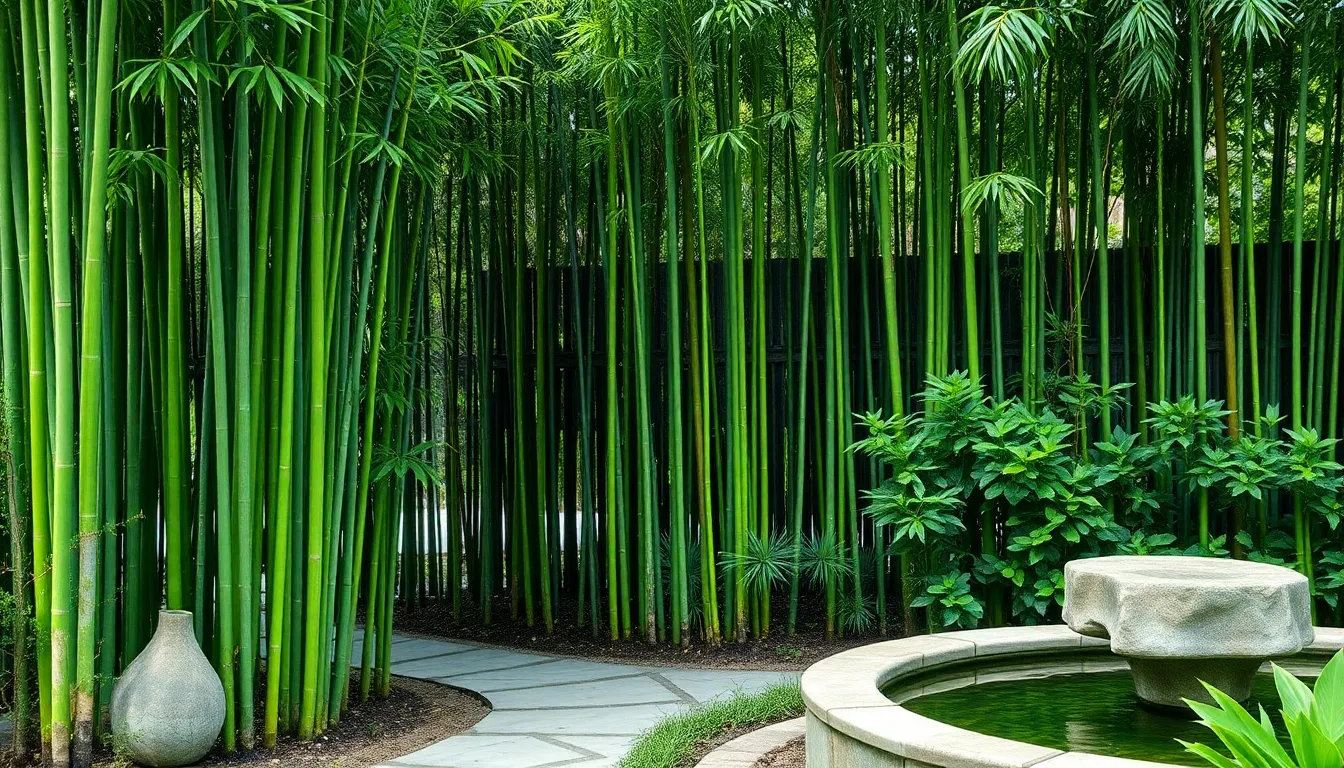
Creating bamboo groves transforms ordinary garden spaces into dramatic focal points that command attention year round. These living installations offer natural screening answers while establishing stunning visual anchors throughout your industry design.
Select Appropriate Species for Your Climate
Phyllostachys aureosulcata thrives in cooler climates and delivers striking yellow-green canes that create year round visual interest. Gardeners in USDA zones 5-9 can rely on this hardy species to withstand harsh winter conditions without important dieback.
Bambusa tuldoides performs exceptionally well in warmer regions and provides dense, upright growth patterns perfect for grove formations. Tropical and subtropical zones benefit from this species’ rapid establishment and consistent performance.
Climate matching ensures your bamboo grove investment succeeds long term rather than struggling against environmental conditions. We recommend consulting local extension offices to verify hardiness zones before selecting species for your exact location.
Fargesia robusta offers excellent cold tolerance for northern gardens while maintaining compact, clumping growth habits. This species eliminates concerns about invasive spreading while delivering the dramatic visual impact we want from bamboo groves.
Plan Strategic Placement for Visual Impact
Strategic positioning creates natural screens that block unwanted views while framing desirable garden vistas. Position bamboo groves along property lines where they’ll provide maximum privacy without overwhelming nearby plantings.
Garden pathways benefit from bamboo grove placement that guides visitors through your industry design. Create natural corridors by positioning groves on alternating sides of walking paths for ever-changing visual flow.
Layering effects develop when we combine bamboo with complementary plants at different heights and textures. Place lower growing perennials and shrubs in front of bamboo groves to create depth and seasonal interest.
Corner installations work particularly well for establishing bamboo groves as they naturally frame outdoor living spaces. These locations provide structural support for the grove while creating intimate garden rooms.
View framing becomes possible when we position bamboo groves to highlight exact garden features like water elements or sculpture. Strategic placement draws the eye toward these focal points while providing elegant natural borders.
Manage Growth to Prevent Overcrowding
Regular pruning maintains grove shape and prevents individual culms from overwhelming the intended design aesthetic. Remove older canes annually to encourage fresh growth and maintain the grove’s visual appeal.
Rhizome pruning controls underground spread and keeps bamboo groves within designated boundaries. Sharp spades can cut through root systems twice yearly to maintain proper grove dimensions.
Physical barriers like rhizome barriers installed 24-30 inches deep prevent unwanted expansion into adjacent garden areas. These underground walls contain bamboo growth while allowing vertical development within desired zones.
Thinning schedules keep bamboo groves healthy by removing approximately one third of mature canes each growing season. This practice improves air circulation and reduces competition between individual plants.
Containment methods include above ground planters and raised beds that naturally limit bamboo spread. Large container installations allow bamboo grove benefits without long term ground commitment or expansion concerns.
Conclusion
We’ve explored many ways bamboo can transform your garden into a sustainable and beautiful outdoor sanctuary. From privacy screens to water features each application offers unique benefits that enhance both functionality and aesthetics.
The versatility of bamboo makes it an ideal choice for gardeners seeking eco-friendly answers. Whether you’re working with a small urban space or a sprawling backyard these bamboo ideas can be adapted to fit your exact needs and design preferences.
Remember that bamboo’s rapid growth and low maintenance requirements make it a smart long-term investment for your garden. With proper planning and the right species selection you’ll create stunning outdoor spaces that continue to evolve and flourish year after year.
Frequently Asked Questions
What are the main benefits of using bamboo in outdoor spaces?
Bamboo offers numerous advantages including rapid growth, low maintenance requirements, and eco-friendly sustainability. It’s versatile enough for various applications from privacy screens to decorative elements, suitable for gardens of all sizes from urban balconies to large backyards. Its natural aesthetic enhances any design theme while being environmentally responsible.
Which bamboo varieties are best for creating privacy hedges?
Clumping bamboo varieties like Fargesia robusta and Bambusa multiplex are ideal for privacy hedges. These species provide controlled growth without becoming invasive, making them perfect for property line installations. They offer excellent coverage while maintaining manageable growth patterns that won’t overwhelm your garden space.
How should bamboo plants be spaced for optimal growth?
Proper spacing depends on your immediate privacy needs versus long-term sustainability goals. Generally, allow adequate room between plants to promote healthy development and prevent overcrowding. Strategic spacing ensures each plant receives sufficient nutrients and sunlight while achieving the desired coverage and aesthetic appeal.
Can bamboo be used to create garden pathways?
Yes, bamboo makes excellent pathway materials. Cut bamboo poles can serve as pathway borders spaced 3-4 feet apart, while bamboo rounds work as eco-friendly stepping stones. Adding solar lights or warm white lanterns creates an inviting atmosphere for evening garden walks while maintaining the natural aesthetic.
How do you build bamboo trellises and support systems?
Bamboo trellises can be constructed using individual stakes or interconnected grids to support climbing plants. Create vertical garden structures to maximize growing space, or design artistic archways as focal points. These systems enhance both plant growth and garden beauty while utilizing sustainable materials.
What types of bamboo water features can I create?
Traditional bamboo fountains make excellent DIY projects, while solar-powered options work well for smaller spaces. Bamboo channel systems can connect different garden zones, and bamboo accents around existing ponds add natural charm. These features create tranquil sounds and enhance the overall garden ambiance.
How can bamboo be used for garden containers and planters?
Large bamboo culms can be repurposed into unique planters maintaining an organic aesthetic. Create hanging garden displays to maximize vertical space or design tiered planting systems that organize plants at different heights. These containers are sustainable alternatives to traditional planters while adding natural beauty.
Is bamboo suitable for outdoor furniture and seating?
Absolutely! Bamboo works excellently for constructing benches, outdoor dining sets, and meditation spaces. It’s durable, eco-friendly, and naturally weather-resistant. Bamboo furniture adds organic charm while providing functional seating areas and gathering spots that blend seamlessly with garden environments.
How do bamboo wind chimes enhance garden atmosphere?
Bamboo wind chimes create melodic harmony using sustainable materials. Hollow bamboo pieces of varying sizes produce rich harmonic layers when placed in areas with consistent airflow. They add soothing sounds to gardens while serving as attractive decorative elements that complement the natural landscape.
What’s involved in establishing a bamboo grove?
Select appropriate species based on your climate, such as Phyllostachys aureosulcata for cooler areas or Bambusa tuldoides for warmer regions. Strategic placement creates natural screens and focal points. Maintain grove health through regular pruning, rhizome barriers, and containment strategies to prevent overcrowding and ensure sustainable growth.
